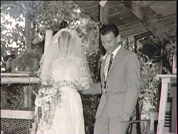 On Valentine’s Day 14 February 2008, the regular feature ’Andere Tijden’ , a history-based program on Dutch television, broadcasted a poignant story about the forbidden love between a Dutch missionary and a young Papuan woman living in former Dutch New Guinea. Their relationship became a huge scandal and the couple fled into the jungle to escape the fury of the local bishop. When they married,
On Valentine’s Day 14 February 2008, the regular feature ’Andere Tijden’ , a history-based program on Dutch television, broadcasted a poignant story about the forbidden love between a Dutch missionary and a young Papuan woman living in former Dutch New Guinea. Their relationship became a huge scandal and the couple fled into the jungle to escape the fury of the local bishop. When they married,
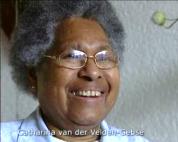 they were excommunicated by the Roman Catholic Church. The young woman of yester year, now aged 70, told her story in a film made by Annegriet Wietsma. Somewhat shyly, yet with humour she spoke about her exceptional youth and her romance with Father Koos, sitting on the couch at her home in Utrecht.
they were excommunicated by the Roman Catholic Church. The young woman of yester year, now aged 70, told her story in a film made by Annegriet Wietsma. Somewhat shyly, yet with humour she spoke about her exceptional youth and her romance with Father Koos, sitting on the couch at her home in Utrecht.
Content:
1. Life with the head-hunters of the Marind-anim
2. Times of change
3. Encounter with a young priest
4. Shift to the Asmat area
5. Bishop visits Catharina
6. Escape to the Jungle
7. Excommunicated by the Vatican
8. Contact with missionary of Reformed Church
9. Converting to the Reformed Church
10. Links
11. Sources
1. Life with the head-hunters of the Marind-anim.
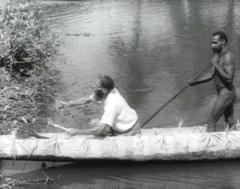 Catharina Gebse was born in 1938 and grew up in the jungle among the Marind-anim, a Papuan tribe on the south coast of former Dutch New Guinea. Up until half a century ago, it was one of the fiercest and most feared tribes of the whole region. To go headhunting, they would sail far and wide and were not at all fazed by sailing hundreds of kilometres over the sea in their canoes made from hollowed out logs, and they travelled as far as the Australian coast. When Australians started to complain to the Dutch authorities about the head hunting raids of these ‘Dutch
Catharina Gebse was born in 1938 and grew up in the jungle among the Marind-anim, a Papuan tribe on the south coast of former Dutch New Guinea. Up until half a century ago, it was one of the fiercest and most feared tribes of the whole region. To go headhunting, they would sail far and wide and were not at all fazed by sailing hundreds of kilometres over the sea in their canoes made from hollowed out logs, and they travelled as far as the Australian coast. When Australians started to complain to the Dutch authorities about the head hunting raids of these ‘Dutch 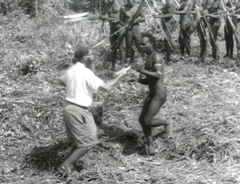 nationals’ from the Marind-anim, it was decided that something needed to be done. After all, one did not want to look the fool in the international arena! Pacifying and converting the natives to Christianity became a priority for the Dutch colonial administration at that time.
nationals’ from the Marind-anim, it was decided that something needed to be done. After all, one did not want to look the fool in the international arena! Pacifying and converting the natives to Christianity became a priority for the Dutch colonial administration at that time.
When Catharine was born, her parents had already become Christians, as is obvious from her name. Her father was a crocodile hunter, who sold the hides to the whites and because of this, he regularly came into contact with the newcomers. Little Catharina was keen to 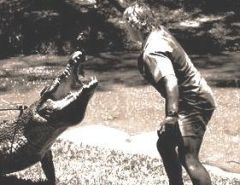 find out about the big wide world out there. Even at the age of four, she was already so in awe of all the knowledge and goods brought in by the Dutch colonials that she wanted to go to school. Catherina, a number of her cousins and other children from her village went to elementary school far away in the coastal town of Merauke. With her older cousin to hold her by the hand, the adventurous young child walked the long journey to the boarding school. It took a good four days to get there. For Catharina this was not all together strange as Papuan youngsters learn to be independent from an early age.
find out about the big wide world out there. Even at the age of four, she was already so in awe of all the knowledge and goods brought in by the Dutch colonials that she wanted to go to school. Catherina, a number of her cousins and other children from her village went to elementary school far away in the coastal town of Merauke. With her older cousin to hold her by the hand, the adventurous young child walked the long journey to the boarding school. It took a good four days to get there. For Catharina this was not all together strange as Papuan youngsters learn to be independent from an early age.
2. Times of change
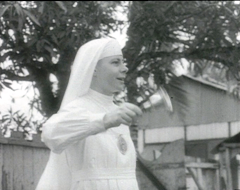 The active involvement of the Dutch colonials, the abundance of goods and all the new commands and prohibitions, brought about huge changes to the south-east of New Guinea. The first missionaries handed out steel axes and tobacco while preaching “love thy neighbour” and the virtues of monogamy at the same time. Dutch administrators followed these missionaries only decades later, equipped with rifles and a book full of rules forbidding the practice of head hunting, sexual orgies and many other indigenous customs and traditions.
The active involvement of the Dutch colonials, the abundance of goods and all the new commands and prohibitions, brought about huge changes to the south-east of New Guinea. The first missionaries handed out steel axes and tobacco while preaching “love thy neighbour” and the virtues of monogamy at the same time. Dutch administrators followed these missionaries only decades later, equipped with rifles and a book full of rules forbidding the practice of head hunting, sexual orgies and many other indigenous customs and traditions.
Catherina growing up at this time of change, was fascinated by the wealth brought in by the whites and wanted to learn how she could acquire such wealth for her own 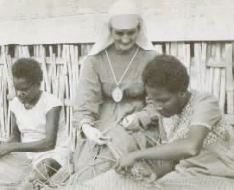 people. Being inquisitive, she wanted to move beyond the world of her tribe. For the Marind-anim the world ended at the point where the sea and the sky touched. But Catharina felt there was more between heaven and earth and she wanted to see this with her own eyes.
people. Being inquisitive, she wanted to move beyond the world of her tribe. For the Marind-anim the world ended at the point where the sea and the sky touched. But Catharina felt there was more between heaven and earth and she wanted to see this with her own eyes.
As soon as Catharina arrived at the boarding school in Merauke, run by the Sisters of our Lady with the Sacred Heart, she had to change what she was wearing. Instead of her grass skirt, she was clad in clothes and from then on she was only allowed to speak in Dutch. She was to remain at this Church School for the next sixteen years.
3. Encounter with a young priest
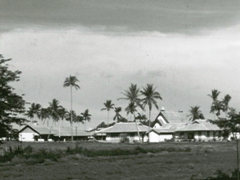 In 1954, the young priest Jacobus van den Velden arrived, straight of the ship from the homeland. He was an inspired young man, eager to bring Christianity to the Papuan people in the hinterlands of New Guinea. The girls form the boarding school sang a song of welcome as the young priest set foot on land. After a two week rest to get over the effects of the long journey, Jacobus – known as Father Koos - received his first assignment. He was sent into the interior where he was assigned to a parish in which the tribes had not had very much contact with the Dutch administration. Koos soon came to love the people and the area he was sent to.
In 1954, the young priest Jacobus van den Velden arrived, straight of the ship from the homeland. He was an inspired young man, eager to bring Christianity to the Papuan people in the hinterlands of New Guinea. The girls form the boarding school sang a song of welcome as the young priest set foot on land. After a two week rest to get over the effects of the long journey, Jacobus – known as Father Koos - received his first assignment. He was sent into the interior where he was assigned to a parish in which the tribes had not had very much contact with the Dutch administration. Koos soon came to love the people and the area he was sent to. 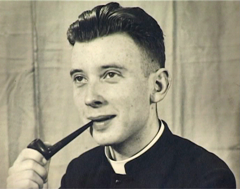 Every time he returned to Merauke to take a breather, he called on Catharina. This was being frowned upon by the priests and the nuns from the local missionary. Father Koos enjoyed Catharina’s cheerful nature, her laughter and her friendly teasing. The feeling of admiration was mutual and today one might say it was love at first sight. But in the fifties, the affectionate relationship that developed was totally unacceptable between a Dutch priest and a Papuan woman. They were in the wrong on two counts: Not only was the young priest bound to celibacy, the Dutch administration strongly discouraged intimacy between a Dutch person and a Papuan national.
Every time he returned to Merauke to take a breather, he called on Catharina. This was being frowned upon by the priests and the nuns from the local missionary. Father Koos enjoyed Catharina’s cheerful nature, her laughter and her friendly teasing. The feeling of admiration was mutual and today one might say it was love at first sight. But in the fifties, the affectionate relationship that developed was totally unacceptable between a Dutch priest and a Papuan woman. They were in the wrong on two counts: Not only was the young priest bound to celibacy, the Dutch administration strongly discouraged intimacy between a Dutch person and a Papuan national.
4. Transfer to Asmat area
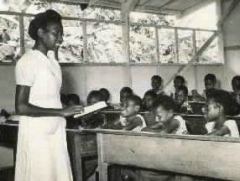 When Catharina had completed her training, she became a primary teacher in Kepi, inland from Merauke, at a school run by the Order of the Sisters of the Sacred Heart. Koos was also stationed in the Kepi area. As a result, the two young people had ample opportunity to get to know each other well. But their friendship was seen as unacceptable and was regarded with suspicion within the small catholic community that they lived in. It led to rumours about
When Catharina had completed her training, she became a primary teacher in Kepi, inland from Merauke, at a school run by the Order of the Sisters of the Sacred Heart. Koos was also stationed in the Kepi area. As a result, the two young people had ample opportunity to get to know each other well. But their friendship was seen as unacceptable and was regarded with suspicion within the small catholic community that they lived in. It led to rumours about 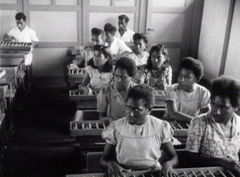 their relationship going ‘beyond the realms of decency’ and that it should not be allowed. The sisters wanting to save Catherina from herself, decided that she should be transferred to the Asmat area along the south coast of New Guinea to become a Head teacher in the village of Agats. Because of this transfer, she became separated from Koos by hundreds of acres of impenetrable bush and swamps. This separation was an attempt to put an end to the relationship.
their relationship going ‘beyond the realms of decency’ and that it should not be allowed. The sisters wanting to save Catherina from herself, decided that she should be transferred to the Asmat area along the south coast of New Guinea to become a Head teacher in the village of Agats. Because of this transfer, she became separated from Koos by hundreds of acres of impenetrable bush and swamps. This separation was an attempt to put an end to the relationship.
5. Bishop visits Catharina
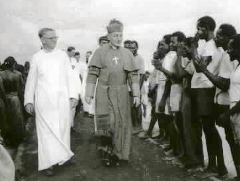 The bishop of South New Guinea, Herman Tillemans, wanted to investigate the matter for himself in order to ascertain whether or not the persistent rumours were true. He visited Catharina in Agats and asked her without further ado if any indecent acts had occurred. But Catharina was not aware of having done anything wrong. As far as she was concerned, they were close friends and she said that it would not even occur to her to have a sexual relationship with a white man. Yet bishop Tillemans was not altogether convinced. He also wanted to quell rumours once and for all. He therefore gave Catharina an ultimatum: She was either to marry one of her fellow teachers as soon as possible or she was to go to a nunnery. The Bishops’ ‘message’ got through to Koos who was really upset by what was happening. He decided to make the long journey to the Asmat in a prauw to ask Catharina if she was feeling as unhappy as he was. He wanted to get away from south New Guinea and start again on the north coast, miles away from the influence of the mission.
The bishop of South New Guinea, Herman Tillemans, wanted to investigate the matter for himself in order to ascertain whether or not the persistent rumours were true. He visited Catharina in Agats and asked her without further ado if any indecent acts had occurred. But Catharina was not aware of having done anything wrong. As far as she was concerned, they were close friends and she said that it would not even occur to her to have a sexual relationship with a white man. Yet bishop Tillemans was not altogether convinced. He also wanted to quell rumours once and for all. He therefore gave Catharina an ultimatum: She was either to marry one of her fellow teachers as soon as possible or she was to go to a nunnery. The Bishops’ ‘message’ got through to Koos who was really upset by what was happening. He decided to make the long journey to the Asmat in a prauw to ask Catharina if she was feeling as unhappy as he was. He wanted to get away from south New Guinea and start again on the north coast, miles away from the influence of the mission.
6. Escape to the jungle
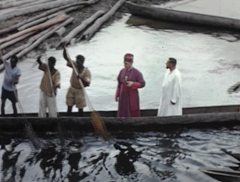 After a day of considering her options, Catharina made her decision: She stepped into the boat with Koos and the two of them escaped into the jungle and headed for the area where Koos had previously worked as a priest. They travelled seven days and seven nights to get there. The first few days they were being chased by the bishop who was absolutely furious. Fortunately, the bishop’s prauw lost track of theirs and the two of them managed to get away. A few months later, they encountered Jan Sneep, a Dutch government official, who was accompanying the French film crew of anthropologist Pierre Gaisseau on their entrepreneurial coast-to-coast journey right across the interior of West New Guinea. Jan Sneep took them back to civilisation in his patrol boat. He also helped them to get to Hollandia, where they arrived towards the end of 1959.
After a day of considering her options, Catharina made her decision: She stepped into the boat with Koos and the two of them escaped into the jungle and headed for the area where Koos had previously worked as a priest. They travelled seven days and seven nights to get there. The first few days they were being chased by the bishop who was absolutely furious. Fortunately, the bishop’s prauw lost track of theirs and the two of them managed to get away. A few months later, they encountered Jan Sneep, a Dutch government official, who was accompanying the French film crew of anthropologist Pierre Gaisseau on their entrepreneurial coast-to-coast journey right across the interior of West New Guinea. Jan Sneep took them back to civilisation in his patrol boat. He also helped them to get to Hollandia, where they arrived towards the end of 1959.
7. Excommunicated by the Vatican
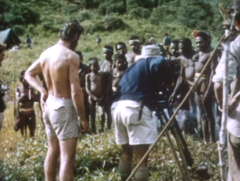 The controversial case was taken up by the Vatican and the couple was excommunicated. According to the ecclesiastical encyclopaedia, excommunication is “a punishment through which a person is excluded from his or her religious community”, the goal of which is to break the resistance of the guilty individual and to make this person repent. The whole of the Catholic Community in Dutch New Guinea, including Catharina’s family, was not to talk to or have any contact with ‘the sinners ‘so as to completely isolate them socially. Most of religious community involved did actually take heed of the ban. Members of Catharina’s family, such as her parents and some of her cousins, did however meet up with her in secret. Through a nuncio, a delegate from the Vatican, an ecclesiastical decree was sent to the jungle at the other side of the globe. To this day Catharina remembers how a local priest came to deliver the official document to their front door. But Koos refused to accept the papers. He had come to his own conclusions.
The controversial case was taken up by the Vatican and the couple was excommunicated. According to the ecclesiastical encyclopaedia, excommunication is “a punishment through which a person is excluded from his or her religious community”, the goal of which is to break the resistance of the guilty individual and to make this person repent. The whole of the Catholic Community in Dutch New Guinea, including Catharina’s family, was not to talk to or have any contact with ‘the sinners ‘so as to completely isolate them socially. Most of religious community involved did actually take heed of the ban. Members of Catharina’s family, such as her parents and some of her cousins, did however meet up with her in secret. Through a nuncio, a delegate from the Vatican, an ecclesiastical decree was sent to the jungle at the other side of the globe. To this day Catharina remembers how a local priest came to deliver the official document to their front door. But Koos refused to accept the papers. He had come to his own conclusions.
8. Contact with a protestant missionary
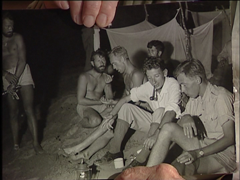 In Hollandia, Koos came into contact with missionary Meeuwis Drost, who had arrived a short time before and whose church had quite a different message to deliver to the Papuans: That of the Free Reformed Church. This was a relatively new denomination within the colony and it had not yet been tainted by the animosity that existed between the Catholic and Protestant missions. Koos took a liking to the refreshing approach of Drost, the first missionary from the Reformed Church to arrive in New Guinea. Catharina and
In Hollandia, Koos came into contact with missionary Meeuwis Drost, who had arrived a short time before and whose church had quite a different message to deliver to the Papuans: That of the Free Reformed Church. This was a relatively new denomination within the colony and it had not yet been tainted by the animosity that existed between the Catholic and Protestant missions. Koos took a liking to the refreshing approach of Drost, the first missionary from the Reformed Church to arrive in New Guinea. Catharina and 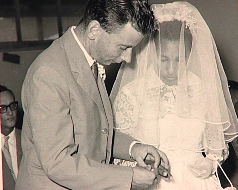 Koos decided to turn their back on the Roman Catholic Church and they subsequently married on 5 April 1960.
Koos decided to turn their back on the Roman Catholic Church and they subsequently married on 5 April 1960.
Catharina knew that the only way for an apostate to be atoned, is to go through a ritual that involves standing outside the church door while being taunted and spat upon by faithful believers as they are entering the church. It was not really a ritual that was still in use but Catharina had been brought up with a very traditional form of Catholicism and believed that this was the only way to lift the ban of excommunication.
9. Conversion to the Reformed Church
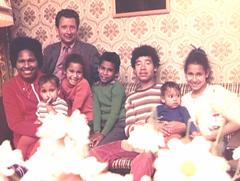 Catharina’s husband Koos converted to the faith of the Dutch Reformed Church, which was in the process of setting up a mission post in New Guinea. Catharina followed her husband in this faith. Soon after, he was sent out as a missionary for the Dutch Reformed Church and continued to work among the Papuan peoples for many more years. In 1974, twelve years after the colony had been handed over to Indonesia, the couple left New Guinea, by then known as Iran Jaya, to live in the Netherlands.
Catharina’s husband Koos converted to the faith of the Dutch Reformed Church, which was in the process of setting up a mission post in New Guinea. Catharina followed her husband in this faith. Soon after, he was sent out as a missionary for the Dutch Reformed Church and continued to work among the Papuan peoples for many more years. In 1974, twelve years after the colony had been handed over to Indonesia, the couple left New Guinea, by then known as Iran Jaya, to live in the Netherlands.
There couple brought up their six children. Eventually they moved to Utrecht where they lived for the remaining years of their life together. Koos continued to work as a 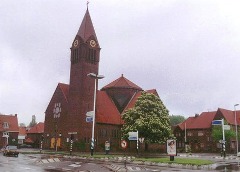 minister right up to his death in 1997. Until the time that Catharina shifted away from Utrecht, she was an active member of the Vrijgemaakte Opstandingskerk, a Reformed Church community in the north–west of Utrecht. She used to love going there and attended two services every Sunday. Catharina did acknowledge missing aspects of her catholic past. Whenever she walks past a catholic church, she experiences a sense of longing, nostalgia for the splendour and ritual of the catholic service, the beautiful language and the liturgy.
minister right up to his death in 1997. Until the time that Catharina shifted away from Utrecht, she was an active member of the Vrijgemaakte Opstandingskerk, a Reformed Church community in the north–west of Utrecht. She used to love going there and attended two services every Sunday. Catharina did acknowledge missing aspects of her catholic past. Whenever she walks past a catholic church, she experiences a sense of longing, nostalgia for the splendour and ritual of the catholic service, the beautiful language and the liturgy.
Two years ago Catharina returned to her birth place, to Merauke and the boarding school attended all those years ago. She made this trip together with the family of one of her daughters. When her daughter wanted to have a look at the little catholic church that her parents used to belong to, Catharina simply refused to put a foot in the door.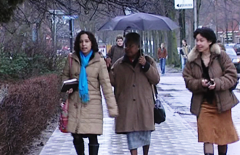 At Catharina’s home there are family portraits of all shapes and sizes next to one another: Black and white photos of naked children and of Catharina’s fellow villagers in grass skirts and penis sheaves, coloured photos of Catharina and Koos and their children. In the window sill, enormous shells are on display, relics from by gone years once used to announce the start of a head hunting raid. A traditional Friesian clock softly ticking forms a part of the still life reflecting Catharina’s past.
At Catharina’s home there are family portraits of all shapes and sizes next to one another: Black and white photos of naked children and of Catharina’s fellow villagers in grass skirts and penis sheaves, coloured photos of Catharina and Koos and their children. In the window sill, enormous shells are on display, relics from by gone years once used to announce the start of a head hunting raid. A traditional Friesian clock softly ticking forms a part of the still life reflecting Catharina’s past.
10. Links:
- Video ‘Zending 50 jaar later’. By Kees Drost and Niels Drost (son and grandson of the very first missionary, Meeuwis Drost) who went on a visit to Papua on behalf of the Dutch Reformed Church.
- Video ‘Missionary go home’. About a Dutch couple sent out by the missionary into the jungle of Papua but told to go home by indigenous tribal leaders.
- Webpage about the 100 years of Roman Catholic presence in Merauke, Papua.
Also refer to theme page on PACE website: Seventy years of Franciscans in Papua
11. Sources:
- Annegriet Wietsma. Video 2008. De Dans van de Paradijsvogel.
- J.A. van der Velden. 1997. Vreemd vliegt de paradijsvogel. Franeker: Uitgeverij van Wijnen.
- Adrian Verbree. 2008. Papua, 50 jaar later. Zwolle: Uitgeverij De Verre Naasten
- Nieuw-Guinea Kronieken nr. 1, 8, 14. 1954, 1957 and 1958 respectively.
-Primary sources (1950’s) belonging to Bert Jannink and Jan Sneep.
- PACE Oral History Resources.2008. Interviewees: Catharina van der Velden-Gebse, Sister Melania, Father Huiskamp and Jan Sneep, Dutch government official. Interviewer: Annegriet Wietsma.
- Advice and comments: Annegriet Wietsma and Nancy Jouwe.